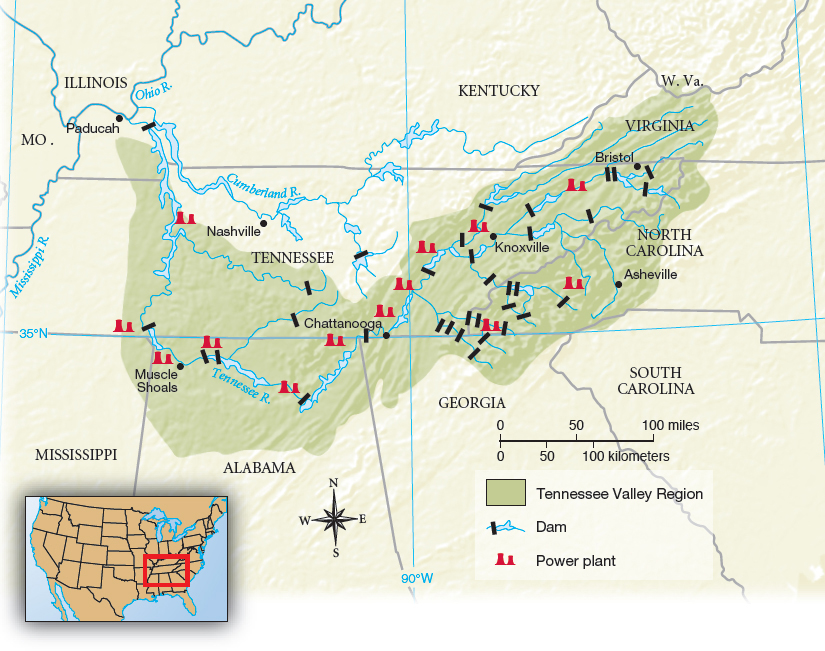Relief and Conservation Programs
Printed Page 718
Patching the nation’s financial structure provided little relief for the hungry and unemployed. A poor man from Nebraska asked Eleanor Roosevelt “if the folk who was borned here in America … are this Forgotten Man, the President had in mind, [and] if we are this Forgotten Man then we are still Forgotten.” Since its founding, the federal government had never assumed responsibility for needy people, except in moments of natural disaster or emergencies such as the Civil War. Instead, churches, private charities, county and municipal governments, and occasionally states assumed the burden of poor relief, usually with meager payments. The depression necessitated unprecedented federal relief efforts, according to New Dealers.
CHAPTER LOCATOR
How did Franklin D. Roosevelt win the 1932 election?
What were the goals and achievements of the first New Deal?
Who opposed the New Deal and why?
How did the second phase of the New Deal differ from the first?
What major political trends changed during the late 1930s?
Conclusion: What were the achievements and limitations of the New Deal?
 LearningCurve
LearningCurve
Check what you know.
The Federal Emergency Relief Administration (FERA), established in May 1933, supported four million to five million households with $20 or $30 a month. The FERA also created jobs for the unemployed on thousands of public works projects, organized into the Civil Works Administration (CWA), which put paychecks worth more than $800 million into the hands of previously jobless workers. Earning wages between 40 and 60 cents an hour, laborers renovated schools, dug sewers, and rebuilt roads and bridges.
The most popular work relief program was the Civilian Conservation Corps (CCC), established in March 1933. It offered unemployed young men a chance to earn wages while working to conserve natural resources, a long-standing interest of Roosevelt. Women were excluded from working in the CCC until Eleanor Roosevelt demanded that a token number of young women be hired. By the end of the program in 1942, three million CCC workers had left a legacy of vast new recreation areas, along with roads that made those areas accessible to millions of Americans. Just as important, the CCC, CWA, and other work relief efforts replaced the stigma of welfare with the dignity of jobs. As one woman said about her husband’s work relief job, “We aren’t on relief anymore. My husband is working for the Government.”
 Federal relief program established in March 1933 that provided assistance in the form of jobs to millions of unemployed young men and a token number of women. CCC workers worked on conservation projects throughout the nation.
Federal relief program established in March 1933 that provided assistance in the form of jobs to millions of unemployed young men and a token number of women. CCC workers worked on conservation projects throughout the nation.
The New Deal’s most ambitious and controversial natural resources development project was the Tennessee Valley Authority (TVA), created in May 1933 to build dams along the Tennessee River to supply impoverished rural communities with cheap electricity (Map 24.3). The TVA set out to demonstrate that a partnership between the federal government and local residents could overcome the barriers of state governments and private enterprises to make efficient use of abundant natural resources and break the ancient cycle of poverty. The TVA improved the lives of millions in the region with electric power, flood protection, soil reclamation, and jobs.

New sources of hydroelectric power helped the New Deal bring the wonders of electricity to country folk, fulfilling an old progressive dream. When Roosevelt became president, 90 percent of rural Americans lacked electricity. Private electric companies refused to build transmission lines into the sparsely settled countryside when they had a profitable market in more accessible and densely populated urban areas. Beginning in 1935, the Rural Electrification Administration (REA) made low-cost loans available to local cooperatives for power plants and transmission lines to serve rural communities. Within ten years, the REA delivered electricity to nine out of ten farms, giving rural Americans access for the first time to modern conveniences that urban people had enjoyed for decades.
CHAPTER LOCATOR
How did Franklin D. Roosevelt win the 1932 election?
What were the goals and achievements of the first New Deal?
Who opposed the New Deal and why?
How did the second phase of the New Deal differ from the first?
What major political trends changed during the late 1930s?
Conclusion: What were the achievements and limitations of the New Deal?
 LearningCurve
LearningCurve
Check what you know.